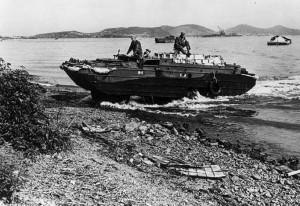
They were built to support the war effort in the Pacific, but WWII-vintage DUCKWs -- DUCKs to the serviceman -- may find use in Haiti.
The world is racing to deliver aid to devastated Haiti, but getting it onto the stricken island has been a problem. Bottlenecks have made it difficult to deliver freight by either air or sea and aid groups, including the U.S. military, are desperately looking for ways to increase the flow before it’s too late.
According to the Wall Street Journal, a Jacksonville shipping firm has ships with cranes which could lift relief cargo to shipside smaller boats, but the problem is there is no way for them to unload efficiently on Haitian beaches.
But actually there is, if those interested just turn to the pages of history.
During the early days of U.S. involvement in World War ii, Army vehicle engineers worked with General Motor Truck and Coach Division engineers to develop an amphibious version of the War Department’s standard cargo truck, a GMC 6×6, better known among the troops as “Deuce and a Half.”
Following GMC nomenclature, the amphibious truck was labeled DUKW—indicating a multi-axled, special purpose vehicle of 1942 origin. Naturally this corporate moniker morphed to the popular name among GIs, sailors and Marines: DUCK.
Ducks enabled Marines to storm from ocean over beaches to capture Japanese-held islands. In Europe, where retreating German armies destroyed bridges behind them, the ETO Ducks easily forded the rivers, carrying soldiers and supplies forward and wounded back.
Therefore they are the perfect answer to at least one of the Haitian Relief challenges, ship to land where ports have been destroyed by the earthquakes.
Unfortunately, none have been manufactured since GM’s contract ended in 1945.
But many retired to war surplus and kept on working for a variety of civilian purposes. Lately, that has been, alas, tourist rides in American cities with ample waterways, such as Boston, Baltimore, Miami and Honolulu.
Moreover, the folks running summertime tourist rides in the Wisconsin Dells at last report had a couple of dozen WWII surplus Ducks in service. And right now in the dead of winter there aren’t a lot of tourists around south central Wisconsin.
It would take a military airlift operation to borrow those Wisconsin Ducks, cut out the tourist seats for cargo hauling and then get them aboard Haiti-bound relief ships in southern ports.
I sent a email note to Crowley Maritime Corporation, suggesting they look into a Duck brigade. Probably nothing will come of it, but it’s worth trying.
Mike Davis is author of Detroit Wartime Industry: Arsenal of Democracy, published by Arcadia in 2007, which includes the story of Duck development and deployment.

Onward Wisconsin Ducks! PR coup if they do… for sure!